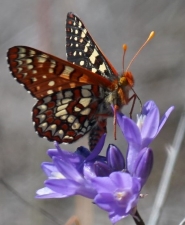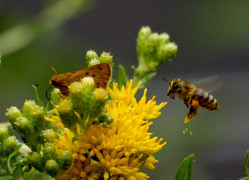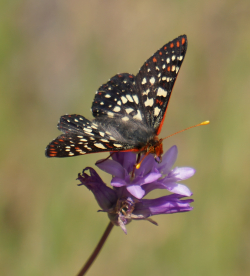Seed Packet Information: Hills of California
Hills of California
We hope you enjoy your seeds from the CNPS SCV Wildflower Ambassadors program. This plant mix is designed to provide flowers over a period of three months in the spring and early summer in a sunny area.
Planting Instructions
Fall through winter is the ideal time to start growing California native wildflowers as these have adapted to capitalize on the fall and winter rains (October-February is best) and bloom in spring. They may be planted through April, but after that it is best to wait until at least September to plant them as they do not do well when planted in late spring or summer.
 Choose A Site & Prepare Your Soil
Choose A Site & Prepare Your Soil
- Choose a spacious site in full sun.
- Prepare your soil (or several very large pots), by removing all existing growth and debris. If your soil is clay, break it up with some compost or cactus soil (sold at nurseries).
- Water thoroughly to help seeds settle into the soil. Continue to water a few times a week, unless it rains, so they don’t dry out after germinating. Seeds should sprout in one to three weeks.
- After you plant your seeds, let the area ‘go natural’ by leaving the leaf litter on the ground. While many butterflies go into chrysalis on stems or other hard surfaces like branches, many others go into chrysalis in the debris. If you rake or blow it, you could accidentally kill or throw them away.
Avoid using pesticides anywhere in your garden, it will kill the beneficial insects such as bees, butterflies, moths, and ladybugs that you are trying to attract. Try to ignore bugs, as they are part of the ecosystem (for instance, hummingbirds eat aphids). If you hose the plant or try to remove pests you may dislodge butterfly or ladybug eggs or kill tiny caterpillars. Avoid using herbicides as they also poison the ecosystem you are trying to nurture.
Plants In The Hills Of California Mix
- Farewell to Spring, Clarkia amoena (hosts White Lined Sphinx Moth, Clark’s Day Sphinx Moth)
- Mountain Garland, Clarkia unguiculata (hosts White Lined Sphinx Moth, Clark’s Day Sphinx Moth)
- Chinese Houses, Collinsia heterophylla (hosts Variable Checkerspot)
- California Poppy, Eschscholzia californica (useful to pollinators, hosts Acmon Blue, Dotted Blue, Mormon Metalmark, etc.)
- Globe Gilia, Gilia capitata (host to Fairy Longhorn Moth)
- Goldfields, Lasthenia glabrata (hosts Small Heliothodes Moth)
- Tidy Tips, Layia platyglossa (hosts Small Heliothodes Moth)
- Blue Flax, Linum lewisii (hosts Variegated Fritillary)
- Miniature Lupine, Lupinus bicolor (hosts Painted Lady, Acmon Blue, Gray Hairstreak)
- Sky Lupine, Lupinus nanus (hosts Orange Sulphur, Painted Lady, Acmon Blue, Gray Hairstreak)
- Arroyo Lupine, Lupinus succulentus (hosts West Coast Lady, Painted Lady, Acmon Blue, Gray Hairstreak)
- Five Spot, Nemophila maculate (hosts Funereal Duskywing)
- Baby Blue-Eyes, Nemophila menziesii (hosts Owlet Moth)
- Lacy Phacelia, Phacelia tanacetifolila – (hosts Bilobed Looper Moth, beloved by bees)
The list of moths and butterflies hosted by these plants is just a sample, these plants are a host to many more - a comprehensive list of butterflies each plant hosts, and details about the plants and butterflies, can be found at Calscape.org
*”Host” = key food source for the caterpillars of these particular butterflies, that co-evolved to specialize over thousands of years. Butterflies die out without these plants.


 CNPS SCV Wildflower Ambassadors (WFA) hand out free native seeds and information at events and library talks, join and assist with tours of local native gardens, enjoy seed packing parties together, pitch in at pollinator gardens and restoration projects and promote native gardening on social media. Above all, they have a good time while inspiring people to start their own native gardens and create habitat for our native bees, butterflies, birds and more.
CNPS SCV Wildflower Ambassadors (WFA) hand out free native seeds and information at events and library talks, join and assist with tours of local native gardens, enjoy seed packing parties together, pitch in at pollinator gardens and restoration projects and promote native gardening on social media. Above all, they have a good time while inspiring people to start their own native gardens and create habitat for our native bees, butterflies, birds and more.  Seed and Garden Information
Seed and Garden Information